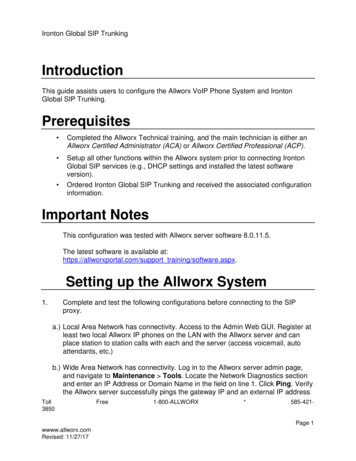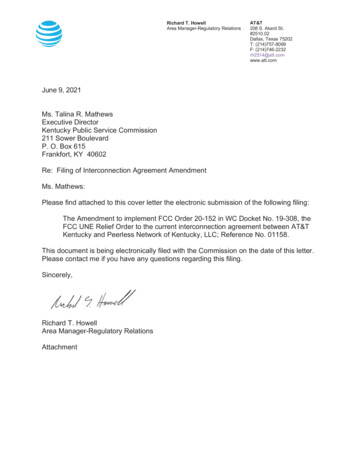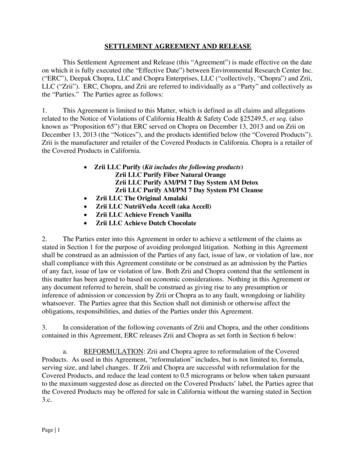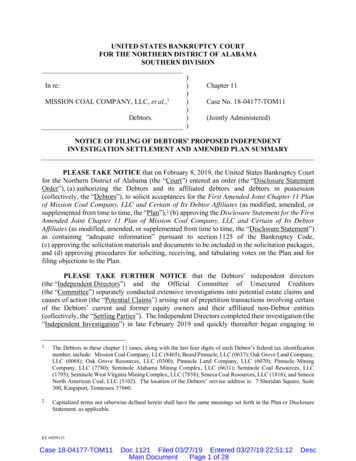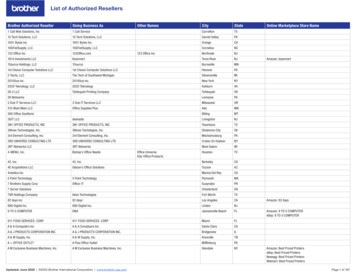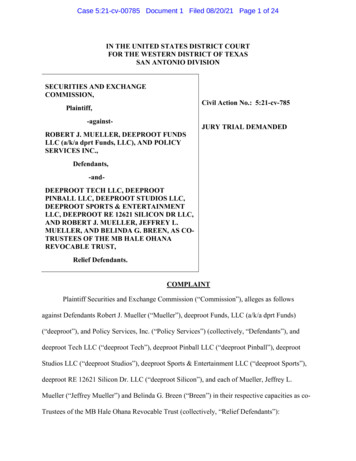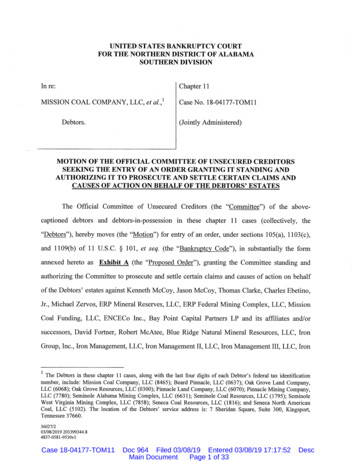
Transcription
Ironton Global LLC February 2014
VoIP phone systems today vary greatly in features, size, type of phone lines they can operate with,wiring they use, and phones (stations) that they use. Voice over Internet Protocol (VoIP) has evolvedgreatly in the past decade. One thing that has not changed however are the fundamentals of VoIPSystems, how they operate, and what they need in order for them to work reliably.For starters, many VoIP Phone systems (PBX) do not rely solely on VoIP phone lines. What are VoIP Phone Lines?While there are proprietary VoIP lines, in general, what is used today is called SIP (Session Initiated Protocol). VoIP/SIP issimply the ability to carry your voice conversations over a data trunk (such as a data T1, Cable Modem, DSL, etc )It is very unusual today to see VoIP phone systems only accepting SIP/VoIP Trunks (a trunk is a phone line). In fact, the vastmajority of VoIP Phone systems today continue to operate on standard Analog Trunks (the same type of lines that you havein your house) and/or PRI (Primary Rate Interface) which is carrier grade 23 phone lines.Why would a VoIP Phone system connect to Analog Trunks or PRI? There could be many reasons for that. For one, clientsmay already have existing contracts on those trunks and they cannot change. The other reason is that they are comfortablein that technology and it has served them well. So why and when do SIP / VoIP trunks come to play?Ironton Global sells a wide variety of SIP trunks ranging from an all you can eat long distance in the U.S. to other plansthat include unlimited calling to Canada, Puerto Rico, and even many countries abroad. Some phone systems allow youto have a variety of trunks and use them in the most appropriate way. For example, a company might still like to connectusing Analog Trunks for most of their inbound or outbound calls (or a PRI or two), except when placing Long Distance calls.LD calls in this case, would exit/use the SIP trunk, therefore saving the consumer long distance fees, and arriving to amore predictable monthly fee. This is called LEAST COST ROUTING. This can vastly decrease cost of operations (oftento the point where the phone system can pay for itself in a very short amount of time, depending on the long distance thecompany normally uses.So what about SIP/ VoIP? Is it dependable? How does it sound?There is a right way and a wrong way to deploy SIP and unfortunately, most of the time, consumers are unclear aboutthe choices they have or what to do and are unfamiliar with technologies that are available to them. Here is what tokeep in mind. Each SIP conversation requires about 84Kb (Kilobit) in data to function correctly (without compression).Compression can sometimes be used or turned on to reduce the voice/data utilization and opti mize networks, butthe more you compress the sound, the worse it sounds. Different vendors have developed different compressiontechniques to get the most out of your bandwidth. One thing for sure, IN VoIP, YOU GET WHAT YOU PAY FOR!!!! Differentproviders might give you different SLAs (Service Level Agreements). Be sure to read them and understand our terms andconditions. Ironton Global has invested a lot into its infrastructure and provides white glove best of breed routes. The callsgo through our TDM DMS switch to insure best possible quality.
When selecting a SIP provider, consider these important factors:The provider has conducted a site survey at the installed facility to determine the right equipment and the right bandwidthThe provider has allocated the CORRECT bandwidth for the trunks needed – typically 84KB per trunk – less if they areusing Codecs for compressionThe provider has ensured that this bandwidth is NOT going through the internet and/or is NOT allocated FOR ANYTHING ELSEThe provider has installed a QoS Routers on the Client’s premise and on THEIR premiseThe provider is MONITORING the status of the lines, the packets and makes adjustments accordingly.The provider has given you and/or the end user an SLA statement insuring all of the above and the terms ofCOMPENSATING the end user should there be an issue.Here is how to roll out VoIP in your Enterprise CORRECTLY:Site Survey and analyze your Network/Infrastructure professionally by someone who can not only provide the results butEXPLAIN THEM and make CORRECTIVE ACTIONS BEFORE you deploy your IP Phone system. Explain to the analystthat you will be installing a VoIP capable system and that you want to make sure your Network is optimized and ready forVoIP and to provide a STATEMENT guarantying their work. Skipping this first is leaving things up to chance or can yield tounpredictable results.Insist on GOOD quality switches. There IS a difference between a 200 switch and a 2000 switch. You are looking for QoSswitches where voice can be prioritized over data. Layer 3 Switches can provide additional functionalities (that you mayneed) such as routing and the ability to monitor the packets of each port and each mac address and can provide extremelyaccurate and granular diagnostic equipment should voice quality become an issue. The IDEAL situation is a Layer 3, QoS,PoE, and Gigabit Switch that is stackable. Going with a CHEAP switch or an existing switch is nearly a GUARANTEE offailure.Just because you bought the right switches does not mean that they are setup correctly. A Network Engineer that knowswhat he/she is doing must setup the QoS correctly on the switches. Ensure that CoS and QoS have been setup, that Voicepackets have been tagged, and much more. Also, reporting is mandatoryEnsure that your Network is cabled properly (CAT 5e is the minimum today and moving forward, CAT 6 is quickly becomingthe de facto standard today). In fact, going forward, when adding cables, insist on CAT6. There is about a 30% up lift in thepricing, but it is well worth the price. Audit your cables. Are they pinched? Is the plastic insulation sticking out of the RJ45connector (if so, that is a bad cable, and it would need to be re-crimped or replaced). Insist on a PATCH PANEL. Also, besure that NONE of your cables exceed 100 Meters in length and have the cablers provide a PRINT OUT to show that thecabling has INDEED been tested and guaranteed for 350 Mbps.
NEVER EVER daisy chain switches (switch to switch, etc ) – this causes major slowdowns on the Network and may causeunpredictable results. If you have 24 stations on your Network (including all Networked Printers, Servers, and any otherdevice that uses Ethernet) then buy a single 24 port layer 3 QoS PoE Switch and have all your cable drops home run to that1 switch. If you have more than 24 Ethernet devices, then you will need to purchase a 48 port or stackable switches. Anything larger than 48 port and you will need to uplink the switches using fiber preferably or buy a core switch. Port Trunking2 switches is a recipe for lag and failure. If you can afford Gigabit switches, GET THEM!Get rid of ALL Hubs if you have them.Ensure that you have a business class Server based Anti-Virus running on every PC and every Server (NOT a consumergrade or Freeware) – These will vary from 20 to 40 per license per year. Make sure the Anti-Virus is up to date and everystation is free of Trojans. All it takes is 1 station being infected to severely cause latency.Ensure that you have a business class Server based Spam Filter (or appliance such as Barracuda or Hosted solution suchas www.redcondor.com or Google Postini) is running. I personally prefer hosted Anti-Spam systems because the spam isfiltered BEFORE it enters your Network (as opposed to an appliance base). Also with hosted systems, there is nothing to install on your servers or workstations and you do not have to worry about updating hardware/software or keeping anythingup. Your Anti-Spam is GONE BEFORE it hits your Network, saving your bandwidth for more important things (like VoIP).Ensure you understand what applications and users are consuming or abusing your Network (such as the www.cymphonix.com appliance). Would you know it if a user is running a Peer to Peer application (downloading illegal music, inappropriate content, etc ) or streaming Video or Audio all day (Radio, etc )?Insist on DEDICATED BANDWIDTH FOR YOUR SIP TRUNKS – shared bandwidth (BYOB – bring your own bandwidth) ISA RECIPE FOR FAILURE NO MATTER WHAT THE PROVIDER TELLS YOU.Insist on QoS Routers end to end – meaning the provider has a QoS router(s) on their end. Also, a systems Engineer mustACCURATELY program the QoS Routers to tag the Voice packetsIt is NOT enough to put a QoS Router on your end, because if that is only what you do, you would have NO control overthat packet when it leaves your Network (how do you QoS the Internet?)
Last, for location to location over the WAN – you can use the internet as a medium of connectivity, but you can NOT QoSthe internet as it is mentioned above. The ONLY way to guarantee voice quality is through a MANAGED MPLS circuit –PERIOD!!!! If you do not have a managed MPLS, then you take your chances.You would think that all of the above would cost a fortune. But in reality, they do not. These are BASIC items that ANY goodnetwork infrastructure today SHOULD have. Whether you use VoIP or not.Most firewalls have a feature called SIP ALG (or SIP Transformations) that may cause issues with nearly all VoIP systems.If you experience phone registration issues, dropped calls or are unable to dial out, we recommend disabling SIP TransformationsIf you have a SonicWALL firewall or ANY Firewall, be sure to DISABLE SIP ALG, otherwise known as SIP Transformations. Disabling it solves most problems caused by these firewall. To disable SIP Transformations on the TZ170 orthe TZ200:Log into the web interface on the SonicWallOn the left, find the VOIP tab. Depending on the version of SonicOS your screen may appear slightly different.Enable “Consistent NAT”Make sure that ALL of the options are unchecked under SIP Transformation.Click on “Apply”.Reboot your VOIP / SIP endpoints.Disabling SIP ALG on the Netgear Firewall/RouterSeveral of today’s commercial routers implement SIP ALG (Application-level gateway), and come’s with this feature enabled by default. While ALG could in many cases help in solving NAT related problems, but the fact is that many routers’ALG implementations are wrong and often modifies SIP packets in unexpected ways, corrupting them and making themunreadable. In general, you would want to disable SIP ALG and configure one to one port mapping on the router. We willshow you how to disable SIP ALG on a Netgear router.Open the Netgear router’s configuration by browsing to its LAN Address (http://192.168.0.1 by default).Log on to the router’s configuration. The default username is ‘admin’ and the default password is ‘password’In the main menu, select Advanced and then WAN SetupEnable the option Disable SIP ALGClick Apply to apply this settingThe Top 2 mistakes that we see CONSISTENTLY with consumers that have problems with their VoIP trunks are:BYOB (Bring your own Bandwidth) – where the provider promises great service over your existing DSL, T1 or Cable.What happens if someone on your Network starts to Email a large file? Or is infected by a virus/Trojan? Again, insist ondedicating the proper bandwidth to your SIP trunks and if you can separate them from your data, QoS the Network andQoS the Router end to end (to your Provider)
Now – let’s talk about the Tele-worker (Remote workers that need to connect to the VoIP System at the office).By distributing its work force nationwide, companies are far less seriously impacted by regional weather conditions, andcan secure better ongoing coverage and support for their customer baseWhile bandwidth in the US has seriously improved in the past few years, internet in homes (or businesses) using Cableand DSL are UNPREDICTABLE at best. Some services SHARE your bandwidth with the rest of the consumers/businesseson the block. Some have good download speeds but horrible upload speeds. Remember that you need 84KB per conversation no matter what. So what happens when you are talking on the phone and sending out Emails? The sound packetmight get distorted. How do you improve on it? There is a reason why a T1 costs around 400 per month and Cable or DSLcosts typically under 100 per month. T1 speeds give you a consistent 1.5 Megabits upload and download speeds (Symmetrical). Whereas Cable and DSL can be as low as 384Kb in some markets in upload speeds. And sometimes, uploadspeed is not just the only problem. Sometimes there is a LAG on the line (as it is the case with some Satellite providers).Wireless (802.11x) can also present a challenge for VoIP Consumers. So, for the Tele-worker, the best way to minimize (noteliminate) problems are:Use a good quality Internet service provider.Test the UPLOAD SPEED (there are many testing facilities on the Internet – just do a search on test my internet speed) – thehigher that speeds, the better off you will be. Look for 1 meg of upload speeds to get a clear conversationRefrain from UPLOADING files or sending Emails while on the line (if you can)Use a good quality router/Firewall, purchased recently and updated with the latest firmware and enable QoSUse Gigabit Ethernet in your house if you can (4 port Gig switches now are well under 100) – especially if you will be usinga soft phone (otherwise, most phones are still 100 Megabits)Be sure you use a good quality business class Antivirus (such as Norton Antivirus) and NOT a freeware and ensure youhave it running on EVERY workstation in your house. Ensure your PCs are up to date, and have the latest patches (even ifyou will be using an IP Phone, that is still a good ideaIP Telephony has improved significantly in the past few years and R&D continues to develop new methods of minimizingproblems. But consider also a failover mechanism. If your Internet fails at your house and that is your only phone, how willyou place calls? Be sure your mobile phone is available to you. Also, ensure that your IP Phone is registering 911 calls toyour HOUSE not to the office. (If you are connected to the office PBX and you dial 911 – you are essentially using one ofthe TRUNKS from your office – so the 911 truck will come to the office NOT to your house – unless there is a way for thatPBX to indicate differently). Be prepared for VoIP, and prepare your Network. At the end of the day, you will find that thesesteps outlined above will provide not only a more pleasurable VoIP experience, but also a better and more reliable andpredictable DATA experience. Reliable networks are no longer a luxury items. Businesses DEPEND on the Network. Spendthe time and the money to improve your infrastructure, use a Managed IT Service provider that uses monitoring (such asKaseya, or Level Platform or others similar to that) to look at your Network 24x7 and provide proactive steps to improve it.
Ironton Global, LLC4242 Mauch Chunk RoadCoplay, PA 18037-9608Main Phone: (610) 794-1000Toll Free: 1-855-226-0230www.irontonglobal.com
Ensure that you have a business class Server based Spam Filter (or appliance such as Barracuda or Hosted solution such as www.redcondor.com or Google Postini) is running. I personally prefer hosted Anti-Spam systems because the spam is filtered BEFORE it enters your Network (as opposed to an appliance base).
